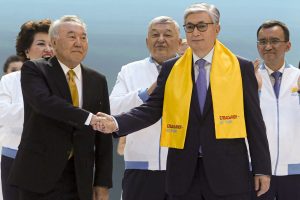Some things, it seems, never change.
In late February 2019, as social unrest was sweeping across Kazakhstan’s main urban centers, Nursultan Nazarbayev – Kazakhstan’s first and, at the time, only president – proceeded to sack the government led by Bakytzhan Sagintayev. In appointing a new prime minister, Asqar Mamin, Nazarbayev promised the population at large that the new cabinet would indeed address the many socioeconomic inequalities affecting Kazakhstan.
Fast forward five years to early 2024 and we find eerily similarly dynamics at play in Kazakhstan’s halls of power. On February 6, 2024, Kassym-Jomart Tokayev, Nazarbayev’s handpicked successor, reshuffled the government, instructing incoming Prime Minister Olzhas Bektenov to quickly develop a comprehensive agenda to relaunch the Kazakhstani economy, which, well into the mid-2020s, remains in a state of stagnation.
The regime’s regular recourse to normally ineffectual remedies (governmental reshuffles) to address entrenched economic problems (stuttering productivity and rampant inequality) suggests that not much has changed in Kazakhstan between 2019 and 2024. This quinquennium, however, has to be seen as one of the most eventful periods in this country’s recent history. During this time, two era-defining moments – Nazarbayev’s resignation on March 19, 2019, and Qandy Qantar, Kazakh for “Bloody January,” in early January 2022 – had the potential to drastically change Kazakhstan’s political scene, altering in decisive fashion the inner workings of Kazakhstani politics.
By revisiting the landmark events that have so far defined the post-Nazarbayev era, I argue we should consider continuity, rather than change, as the most appropriate lens to trace the trajectory followed by Kazakhstani politics after Nazarbayev’s momentous withdrawal from the presidency. How do we explain, in other words, the minimal degree of political transformation experienced by Kazakhstan across the last five years?
The very event that opened the post-Nazarbayev era needs some reassessment to begin with. Nazarbayev’s voluntary relinquishment of the presidency constituted an unprecedented decision for a leader who enjoyed unencumbered power all the way up to the end of his long tenure (1991-2019). Even more extraordinary was the appointment of a handpicked successor with no family links to Nazarbayev himself. The Kazakhstani transition was in this sense different from those completed in other Caspian states, namely Azerbaijan and Turkmenistan, where dynastic succession within the Aliyev (2003) and the Berdimuhamedov (2022) families entrenched local authoritarian governance for the long run.
The tranzit vlasti (Russian for “power transfer”) completed in Astana throughout 2019 was a unique development. It came to signal the conclusion of the very first non-dynastic, managed transition out of authoritarian rule attempted across post-Soviet Eurasia. Ultimately, however, many of the problems that routinely returned to affect Kazakhstan across the last five years originated in the 2019 transition.
Nazarbayev’s resignation, and Tokayev’s subsequent accession to the presidency, were meant to perfect a process of leadership change rather than pursuing a more encompassing agenda of regime transformation. Kazakhstani politics, in other words, was to remain firmly non-democratic even after the country’s first post-independence leader had left his post.
































